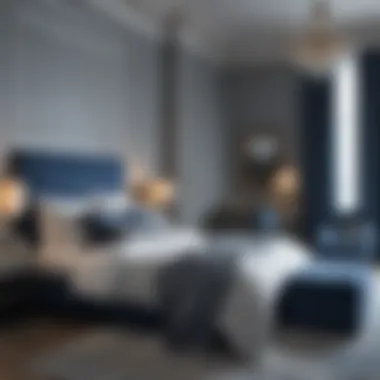Exploring Gender Neutral Bedroom Colors for All


Intro
In recent years, the concept of gender neutrality has gained significant traction in various domains, including interior design. Bedrooms, as personal sanctuaries, are no exception. The focus on gender neutral color palettes addresses the growing desire for a more inclusive approach to interior aesthetics. This article dissects the significance of gender neutral bedroom colors and how they resonate with diverse tastes and preferences.
Understanding the relationship between color and psychology is essential in this discussion. Colors can evoke emotions, influence moods, and create desired atmospheres. Therefore, selecting the right hues is critical. This article will examine a range of suitable colors, their psychological effects, and practical tips for applying them effectively. Additionally, it will touch on how to maintain balance and harmony within those color choices.
"Color is the keyboard, the eye is the harmony, the soul is the piano with many strings."
The journey through gender neutral bedroom colors reveals much more than aesthetics; it presents a framework for enhancing personal spaces in a thoughtful manner. Let's explore the leading styles and effective color palettes that champion gender neutrality.
Understanding Gender Neutrality in Design
The concept of gender neutrality in design is becoming increasingly relevant in contemporary discussions about interior spaces. This importance stems from the wider recognition of diverse identities and preferences in today's society. Gender-neutral designs aim to create environments that are welcoming and inclusive for all individuals, regardless of gender identity.
One of the key elements of gender neutrality in bedroom design is its capacity to break free from traditional color norms that often associate certain hues with masculinity or femininity. This flexibility allows homeowners to choose colors based on personal taste rather than societal expectations. Such choices can contribute positively to the overall atmosphere of a space. A well-designed, gender-neutral room can evoke calmness, comfort, and a sense of belonging.
There are several benefits to consider when implementing gender-neutral principles in bedroom design. First, these designs promote inclusivity and allow for a broader range of expression. They provide a space where everyone can feel at ease, which is crucial for relaxation. Additionally, employing gender-neutral colors can often lead to a timeless aesthetic that transcends trends. This can enhance the longevity of design choices, as they may not feel outdated over time.
"In gender-neutral spaces, the focus shifts from color norms to personal expression and comfort."
Moreover, as societal views evolve, the methods of incorporating gender neutrality into design also progress. This evolution involves more than just color selection; it encompasses how individuals interact with their spaces.
Historical Context of Gender Neutral Designs
Historically, color choices in interior design have been heavily influenced by societal norms that prescribe specific colors for different genders. Traditionally, colors such as pink and pastel shades were often viewed as feminine, while darker hues like navy blue or green were associated with masculinity. Over the decades, this view has evolved significantly.
The women’s rights movement and the LGBTQ+ rights movement have played pivotal roles in reshaping perspectives on gender and design. These movements have opened the door for a more expansive understanding of gender, allowing homeowners to reject binary associations with color. In the 20th century, designers like Florence Knoll contributed to contemporary aesthetics that emphasized functionality and comfort without gender constraints.
Current Trends in Gender Neutral Aesthetics
Today, the trends in gender-neutral aesthetics reflect a blend of tradition and modern sensibilities. Homeowners increasingly favor palettes that include soft greys, warm beiges, and earthy tones. These colors invoke a sense of balance and serenity that appeals to a wide audience.
Additionally, many designers now embrace vibrant shades like teal or mustard yellow within gender-neutral frameworks, allowing for personalization without leaning towards gendered expectations. Decor elements such as furniture, artwork, and textiles are also being created with gender neutrality in mind.
With the advent of online platforms and social media, individuals share their interpretations of gender-neutral spaces. This sharing fosters a community that inspires new ideas and motivates others to embrace color palettes and decor options that reflect their own identities and values.
Understanding gender neutrality in design is not merely about colors; it is a manifestation of a broader move towards inclusivity in the spaces we inhabit.
Key Principles of Color Theory
Understanding color theory is essential for creating a cohesive and inviting space such as a bedroom. Color influences perceptions, emotions, and even behaviors, making it a powerful tool in interior design. The principles of color theory serve as a framework for choosing a palette that not only enhances aesthetic appeal but also aligns with the intended atmosphere of the room.
The Role of Color in Interior Design
In interior design, color does more than just beautify; it establishes mood and cohesiveness in a space. Every color conveys a specific feeling or reaction. Lighter colors tend to create an expansive atmosphere, making a room feel larger and more open. Conversely, darker hues foster a sense of warmth and intimacy.
When choosing a gender neutral palette, it is crucial to consider how each color interacts with light and its surroundings. A well-curated selection invites balance and harmony, promoting an inviting environment. Color can define areas, highlight features, and make transitions between spaces seamless.
Here are some considerations when selecting colors for interiors:
- Light Reflection: Test colors under various lighting conditions to see how they change throughout the day.
- Compatibility: Ensure colors complement existing furniture and decor.
- Usage Purpose: For bedrooms, soothing colors are favorable for relaxation and rest.
Psychological Effects of Colors
Colors have profound psychological effects that can impact daily life. Understanding these effects helps in making informed choices that promote well-being. For example:
- Blue: Often associated with calmness and peace, soft blue tones can evoke feelings of tranquility.
- Green: This color symbolizes nature and balance. It is refreshing and can help alleviate stress.
- Yellow: A more stimulating color, it can uplift spirits but should be used sparingly in a bedroom.
"Color is the keyboard, the eyes are the harmonies, the soul is the piano with many strings."
- Wassily Kandinsky
Gender neutral designs benefit from an awareness of these psychological elements. By mixing shades that promote positive feelings, one creates a bedroom that not only looks pleasing but also supports emotional health.
In summary, grasping the key principles of color theory equips homeowners and designers alike with the knowledge to choose suitable colors, ensuring functionality, aesthetic pleasure, and emotional satisfaction in their living spaces.
Choosing the Right Gender Neutral Colors
Selecting appropriate colors for a gender neutral bedroom is vital. It establishes an atmosphere that is inclusive and comforting. Choosing these colors requires consideration of various aspects including emotional impact, aesthetic appeal, and personal preferences.


Colors can influence mood and perception in a space. Creating a bedroom that resonates with individuals' unique styles while remaining gender neutral is essential. The right colors can help in fostering an inviting environment, supportive of relaxation or creativity.
Neutral Tones: The Foundation Colors
Neutral colors often serve as the backbone of any design. They provide a calm foundation and allow flexibility for personal touches through accents and accessories.
Whites and Off-Whites
Whites and off-whites are versatile choices. They contribute a sense of spaciousness and brightness to any bedroom. A key characteristic is their ability to reflect light, creating an airy atmosphere. This makes them popular as they make a room feel larger.
Unique Feature: They allow for easy pairing with bolder accents, enhancing the visual appeal without competing with other colors. One disadvantage is that they may appear stark or cold if not balanced with warmer tones or textures.
Grays
Grays are appreciated for their understated elegance. They can range from cool to warm tones, offering a depth that may be comforting or modern. A key characteristic is their adaptability; they work well with almost any color scheme and are fundamental to modern designs.
Unique Feature: Gray can evoke different feelings depending on its shade. Light grays provide calm, while darker grays can add sophistication. However, they can sometimes feel dreary if not properly lit or complemented with lively colors.
Beiges
Beiges are warm, inviting, and create a softer backdrop compared to stark whites or grays. A key characteristic is their versatility in pairing with both cool and warm tones. They are beneficial for achieving a cozy atmosphere.
Unique Feature: Beiges can bring a touch of earthiness to a space, making it feel grounded. A potential drawback is their tendency to blend into the background if not accented thoughtfully.
Pastel Shades: Soft Yet Inviting
Pastel shades add an element of gentle warmth. They are ideal for creating a serene environment. Their softness can be particularly appealing in bedrooms.
Soft Blues
Soft blues are refreshing and calm. They are known to have a soothing effect. A key characteristic is their connection to nature and the sky. This creates an expansive and tranquil feeling in a bedroom.
Unique Feature: Soft blues pair well with a range of other colors, allowing for diverse accents. However, they can appear too cool if not balanced with warmer tones in decor.
Pale Greens
Pale greens embody tranquility and nature. They bring a sense of growth and renewal into a space. A key characteristic is their ability to infuse energy while remaining calming. This makes them especially valuable in bedroom designs.
Unique Feature: They encourage a connection to the natural world. One disadvantage is that some shades can seem overly vibrant if not managed carefully, which can detract from the desired calming effect.
Muted Pink
Muted pink tones can be interpreted as both warm and inviting. They provide a gentle pop of color that contributes to a soothing environment. A key characteristic is their ability to soften a space without overwhelming it.
Unique Feature: Muted pinks blend seamlessly with various neutral tones. However, they can sometimes be perceived as overly delicate, which may not suit all personal styles.
Bold Choices: Darker Tones
Darker tones can deliver substance and depth. These colors can add drama and sophistication if appropriately executed in a gender neutral space.
Navy Blue
Navy blue is a classic choice that denotes elegance and strength. A key characteristic is its versatility in varying styles. It can be soothing yet powerful, influencing the atmosphere of the room significantly.
Unique Feature: Navy pairs well with vibrant colors to create contrast. The risk is that navy can make a room feel smaller if not used wisely with lighter elements.
Forest Green
Forest green connects to nature and fosters a sense of serenity. A key characteristic is its grounding effect on a space. Its connection to the natural world makes it a calming option.
Unique Feature: Forest green can invigorate a space while still supporting a peaceful environment. Still, it may need brighter accents to avoid feeling too dark.
Charcoal
Charcoal is bold and modern. Often used as a base to build upon, a key characteristic is its ability to anchor a color palette effectively. It blends well with other shades to create depth in a bedroom.
Unique Feature: Charcoal exudes sophistication. The downside is that if overused, it can create an oppressive environment if not balanced with lighter colors.
Color Combinations for a Balanced Space
Creating a visually appealing bedroom involves more than just selecting individual colors. Color combinations play a pivotal role in establishing the mood and aesthetic of the space. This section emphasizes the need for thoughtful color pairings to ensure a harmonious and inviting environment. A well-executed color scheme enhances the overall design, making the space not only functional but also a reflection of personal style.


Complementary Color Pairings
Complementary color pairings leverage colors from opposite ends of the color wheel. This combination can create a striking contrast that draws the eye and stimulates interest. For instance, pairing a muted green with a warm peach can evoke a sense of tranquility while adding warmth. When choosing complementary colors, it is essential to ensure that one color does not overwhelm the other.
To achieve a balanced look in a gender neutral bedroom, you might consider these combinations:
- Soft gray and blush pink for a subtle yet enticing feel.
- Pale blue and soft orange to instill calming vibes with a hint of cheer.
Effectively using these pairings can transform a room, providing depth and dimension while maintaining the inclusive nature of gender neutral design.
Monochromatic Schemes
Monochromatic schemes revolve around variations of a single color. This strategy grants simplicity while allowing for an exploration of texture and pattern. For example, a range of shades from light to dark gray can convey sophistication and elegance without becoming dull.
When utilizing a monochromatic palette, it is vital to incorporate different textures to create visual interest. Using various fabrics like linen, cotton, and velvet can break the monotony while adhering to the intended color scheme. This approach is ideal for those who appreciate minimalism but want to maintain warmth in the bedroom. As a tip, consider adding accent pieces of darker or lighter shades to provide contrast without straying from the monochromatic theme.
Accent Colors in Gender Neutral Designs
Accent colors serve as the lifeblood of any color scheme. They infuse personality and vibrancy into the space, often defining the character of the bedroom.
Selecting the right accent color can elevate the overall aesthetic. When applying accent colors, think about how they interact with the foundation colors. For gender neutral designs, certain hues work exceptionally well as accents:
- Mustard yellow that can brighten a muted palette.
- Teal that complements soft grays or pastels nicely.
- Burnt orange that adds warmth and a hint of coziness.
The key is to keep accent colors proportional; they should enhance the room without being overpowering. By consciously integrating these elements, one can achieve a truly balanced space that caters to personal style while embracing the principles of gender neutrality.
Balancing colors is not just about aesthetics—it also shapes the emotional experience of a space.
In summary, combining colors thoughtfully enhances a bedroom's design. The right pairings ensure a cohesive, inviting, and thoughtful atmosphere. Whether you opt for complementary colors, embrace a monochromatic scheme, or incorporate strategic accent colors, clarity in your choices will yield a space that feels harmonious and well-designed.
Practical Implementation of Color Selections
Understanding how to practically implement color selections is essential for achieving a harmonious and inviting gender neutral bedroom. The choices made in color application significantly influence the room's ambiance and appeal. This section will discuss various methods of incorporating colors effectively, taking into account functionality, personal preferences, and aesthetic balance. By strategically implementing selected colors, one can create an inclusive and nurturing environment.
Painting Techniques for Bedrooms
Wall Finishes
Wall finishes play a crucial role in the visual impact of a bedroom. They significantly affect how colors are perceived. A matte finish often softens the light in the room, creating a calm atmosphere, while a gloss finish can reflect light, adding vibrancy.
- Key Characteristic: Durability and maintenance. Gloss finishes are easier to clean but may highlight imperfections. Matte finishes, while beautiful, might require more upkeep.
- Beneficial Choice: Matte finishes are generally preferred in bedrooms for their ability to provide a soothing aspect. They can help in producing a relaxed environment, ideal for rest.
- Advantages: Matte wall finishes can successfully absorb light, allowing for a more cohesive and understated look that doesn’t compete with other decor elements. Gloss finishes, however, offer the benefit of easy cleaning, making them practical in rooms that may experience higher wear and tear.
Accent Walls
Accent walls serve as a powerful design tool in gender neutral bedrooms. They allow for the introduction of bolder colors without overwhelming the space. An accent wall can draw attention and add depth to the room.
- Key Characteristic: Focal points. An accent wall establishes a striking visual element. Choosing a darker shade for the accent can provide contrast, making the room more interesting.
- Beneficial Choice: Accent walls can be beneficial in monochromatic designs where a single color is used throughout. They break monotony and grab attention effectively.
- Advantages: By using an accent wall, you can integrate a pop of color without fully committing to more intense shades throughout the entire room. This approach also allows for flexibility in changing decor styles over time.
Incorporating Colors Through Textiles
Bedding Choices
Bedding choices can significantly impact the color scheme in any bedroom. The colors and patterns selected for bedding create a foundational aesthetic.
- Key Characteristic: Versatility. Bedding can easily be changed or layered to fit different seasonal moods or personal tastes.
- Beneficial Choice: Neutral or soft pastels in bedding can promote a peaceful sleep environment. They also serve as a backdrop for other bolder decor items.
- Advantages: Textiles can either enhance or soften color choices within the room. Carefully selecting hues in bedding can help stabilize visual weight in the design.
Curtains and Drapes
Curtains and drapes add another layer to the color dynamics of a bedroom. They frame windows while influencing the light entering the room.
- Key Characteristic: Light filtration. Heavier fabrics can provide insulation and block light, while sheer fabrics allow soft illumination.
- Beneficial Choice: Light-colored curtains can help a room feel larger and brighter, making them a popular choice in gender neutral designs.
- Advantages: The versatility of curtains allows for both aesthetic appeal and functional benefits. They can easily be replaced as styles or color preferences evolve.
Decorative Accessories
Artwork
Artwork can encapsulate the essence of a bedroom's design. The choice of art can introduce a range of colors and evoke specific feelings.
- Key Characteristic: Emotional connection. Art often resonates with personal experiences, making it a meaningful addition.
- Beneficial Choice: Selecting gender neutral art can enhance the overall vibe of the space without imposing a particular gendered aesthetic.
- Advantages: Well-placed artwork can serve as a conversation starter, contributing personality to the bedroom.


Rugs
Rugs are essential pieces that can ground the design of a bedroom. They often serve as color anchor points that bring cohesion to different elements.
- Key Characteristic: Comfort and style. A good rug offers both warmth underfoot and visual depth.
- Beneficial Choice: Neutral-toned rugs provide flexibility to change the surrounding decor without clashing.
- Advantages: Rugs can also help in softening sound and maintaining a cozy atmosphere, especially in larger rooms where echoes may be a concern.
Pillows
Pillows provide an easy way to experiment with color in a room. They are relatively inexpensive and can be changed frequently.
- Key Characteristic: Layering. Different textures and colors in pillows can add complexity to a bedroom's aesthetic.
- Beneficial Choice: Neutral linen or cotton pillows can serve as a calming base for more vibrant or patterned variations.
- Advantages: Pillows allow for quick updates to the look and feel of a bedroom, facilitating an engaging yet easy transition to seasonal themes.
Maintaining a Cohesive Aesthetic
Maintaining a cohesive aesthetic is crucial in creating a visually appealing and harmonious bedroom. A unified color scheme enhances the overall ambiance and makes the space feel tranquil. This is vital when choosing gender neutral colors, as these tones should work together seamlessly.
A key element in achieving this is ensuring color harmony. This concept relates to how different colors interact with each other, creating an effect that is pleasing to the eyes. When creating a gender neutral bedroom, it is beneficial to select a limited palette. By doing so, you reduce the risk of clashing colors. A thoughtful selection of shades allows for better integration of various decor elements, ultimately leading to a well-rounded appearance in the room.
Furthermore, considering the psychological effects of colors is important. Different hues evoke different emotions and reactions. For example, soft grays can bring calmness, while beige tones provide warmth. When choosing colors, house owners should keep in mind how each color responds to natural light and how it interacts with other design elements.
Essential benefits of maintaining a cohesive aesthetic include:
- Visual Appeal: A harmonious space is more attractive and inviting.
- Emotional Well-Being: The right combination of colors can enhance mood and promote relaxation.
- Personal Connection: A space that reflects personal style fosters a sense of ownership and comfort.
In summary, maintaining a cohesive aesthetic in gender neutral bedrooms is not just about personal preference. It is about creating a harmonious environment that promotes both style and emotional well-being.
Ensuring Color Harmony
Ensuring color harmony involves understanding the relationships between colors. This means knowing which colors complement each other and which ones may clash. A commonly used approach is the color wheel, which can guide selections and combinations. Using analogous colors—those that are next to each other on the wheel—often produces a serene effect.
To further enhance color harmony, consider the following tips:
- Use one dominant color and select one or two accent colors.
- Incorporate various shades and tints of the same hue for added depth.
- Avoid overly bright or saturated colors, as they can create a sense of chaos.
Adapting to Personal Style
Adapting to personal style is essential in making any space feel unique. While gender neutral coloring offers a basis for design, individual preferences must be reflected. This can be done through the careful selection of decor, furniture, and accessories. Personal touches, such as artwork or family photos, can provide character to a space.
When incorporating personal style, consider these approaches:
- Mixing Textures: Different materials can add variety and interest without compromising color harmony.
- Layering Colors: Choose several hues within the same color family to create a sense of depth while ensuring balance.
- Flexibility: As preferences change, allow room for experimentation. Changing accessories with the seasons can give the space a fresh look.
Future of Gender Neutral Color Trends
The future of gender neutral color trends plays a significant role in reshaping personal spaces. It reflects evolving societal norms and a growing acknowledgment of diversity in preferences. In today’s world, where traditional gender roles are increasingly blurred, the importance of gender neutral colors becomes evident. These colors allow everyone to express their identity while fostering inclusivity. With a shift towards personalization, individuals seek to create environments that resonate with their values rather than conforming only to conventional norms.
Emerging Color Palettes
Emerging color palettes indicate a strong movement towards softer, more versatile hues. Designers are experimenting with new combinations that blend unexpected shades. For instance:
- Soft earth tones that evoke a sense of calmness
- Muted pastels infused with gray for a more modern feel
- Bold jewel tones that add depth without leaning towards overly specific gender associations
These palettes serve not just aesthetic purposes but also psychological benefits. Colors like sage green or dusky rose have shown to promote relaxation and well-being. As these palettes gain traction, they inspire home owners to strive for individuality in their spaces while remaining accessible and neutral.
Sustainable and Inclusive Choices
As the design world embraces sustainable practices, the focus on eco-friendly materials becomes essential. Sustainable choices do not just emphasize environmental responsibility but also promote inclusivity. For instance, many brands are developing paint lines that utilize natural pigments and non-toxic ingredients. Choosing paints from companies advocating for sustainability is a way to support ethical practices.
Further, inclusivity in the design can incorporate influences from different cultures. Engaging with diverse perspectives helps in building richer color narratives that resonate universally. It creates an opportunity to appreciate different lifestyles while staying aligned with gender neutrality. Ultimately, the future of gender neutral color trends lies in the balance of personal expression, sustainability, and inclusivity.
Closure: The Importance of Gender Neutral Spaces
In today’s societal context, the conversation around gender neutrality extends beyond language and attire; it significantly influences interior design, particularly in creating gender neutral bedrooms. This article has thoroughly explored the colors that define this movement, emphasizing inclusivity and diversity in aesthetic choices. The importance of gender neutral spaces lies in acknowledging the necessity for environments that reflect a broader understanding of identity and preference.
A gender neutral bedroom serves as a sanctuary where individuals can express themselves without the constraints of traditional gender-based color norms. By fostering a space that values neutrality, one can enjoy the psychological benefits associated with calming and harmonious colors. Soft whites, muted pastels, and rich neutrals not only create a visually appealing atmosphere, but they also yield emotional stability.
Considerations in designing such spaces include:
- Inclusivity: Gender neutral design welcomes varied tastes, making any space more relatable and personalized.
- Comfort: Spaces that resonate with personal comfort levels enhance relaxation and restfulness.
- Flexibility: Neutral tones adapt easily to changing preferences or trends without requiring extensive makeovers.
Furthermore, the dialogue surrounding gender neutrality in interior spaces contributes to a more progressive view of personal identity. It invites individuals to partake in the design process without feeling boxed into stereotypes based on color associations.
"A color palette that embraces gender neutrality fosters understanding and acceptance in a diverse society."
For homeowners and housewives, incorporating gender neutral colors can lead to enhanced quality of life. It transforms living spaces into reflections of personal comfort rather than outdated gender norms. Additionally, this movement is becoming increasingly relevant as new generations seek to create homes that genuinely resonate with their identities.
In summary, the importance of gender neutral spaces should not be underestimated. They reflect a modern understanding of inclusivity and personal expression, promoting well-being and satisfaction within the home. As design considerations continue to evolve, embracing gender neutrality in bedroom colors becomes not just a trend, but a necessary step toward more holistic, welcoming spaces.















